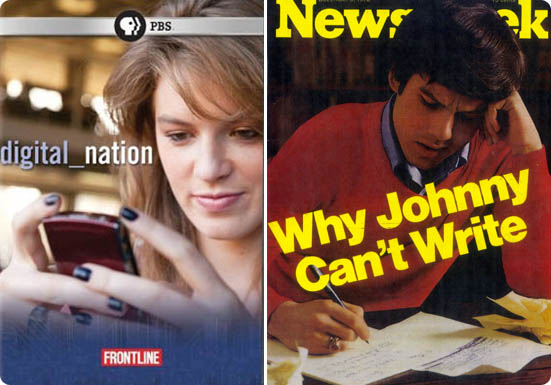Contrast (part 1/2)>> Comparing Johnny and Eliza as Literacy Symbols
<< In order to develop what is different about the contemporary construction of literacy crisis, I will pause to analyze two emblematic images of literacy crisis rhetoric side-by-side: the young man shown on the cover of the 1975 article, “Why Johnny Can’t Write” (referred to hereafter as “Johnny” to make describing him easier) and “Eliza” from the cover of 2010 Digital Nation, whom I introduced earlier.

Both students’ bodies fall under our gaze, and it is clear that the viewer is positioned to intrude on their everyday literacy activity without needing their permission or consent. The two students are portrayed in terms that are eerily similar in some ways: their respective emblematic writing technologies in hand, obvious markers of class and status in their class rings, perfect coifs, and collegiate garb. (It makes you wonder a little whether someone on the Digital Nation staff fashioned this shot of Eliza to purposefully recall Johnny’s image.) Johnny, of course, uses a pen and paper, the writing technologies we would expect to be in hand in 1975 and Eliza, as I described previously, holds her Blackberry.
Is Distraction What Separates the Two Representations?
Neither of these two students seems particularly distracted by the environment around them—both direct complete attention toward the writing technologies dominant within their scenes. The biggest clue to the key difference between the two is developed in their body language, our suppositions about the kinds of texts they are interacting with, and the attitudes they exhibit toward those texts. Johnny seems genuinely perplexed and frustrated by the task at hand. With all the rumpled paper and furrowed brow, we are sure that he is engaged in a writing task that is not routine or familiar to him—one that almost certainly must be an academic writing task with which he is struggling. Eliza, by contrast, seems happy. Unlike Johnny, Eliza’s gaze does not lead us to believe she’s reading or writing something sanctioned by “us” literacy experts—an essay on Shakespeare or Dickens (or even on discourse communities or rhetorical situations, for that matter). We would have to bet she is immersed in a text to a friend, updating her Facebook status, checking in on Twitter or Pinterest to see what her friends have posted since her last class, or checking out the latest Tumblr meme site. Compared with Johnny, Eliza seems more carefree and relaxed, more content in her own world. Read as a symbol of literacy, she does not require the instruction of literacy educators to be successful in the task in which she is engaged.
Or is it something else?
As I described, the written report attached to Johnny’s image focuses primarily on students’ linguistic practice and has a strong racial undercurrent connected to the influx of African American Language in public schools. However, the report also focuses briefly on the negative impact of technologies. The technology of focus in “Why Johnny Can’t Write” is the television, and its effect is described in two major themes. First, the report argues that time spent listening to the "simplistic spoken style of television" instead of reading leads to informalities in language use (59). Second, Sheils argues that TV encourages a non-active stance toward literacy acquisition as “the passiveness of the viewing. . .seems to have a markedly bad effect on a child's active pursuit of written skills" (59). The caption that lies underneath the included picture of children watching TV reinforces this connection between the television and inactivity: “Passive voice: TV entertains, but demands no really active learning” (58). Importantly, with the shift from 1975’s Johnny to 2010’s Eliza, we shift from fearing literacy passivity to activity, from focusing on linguistic difference to unruly embodiment. >>